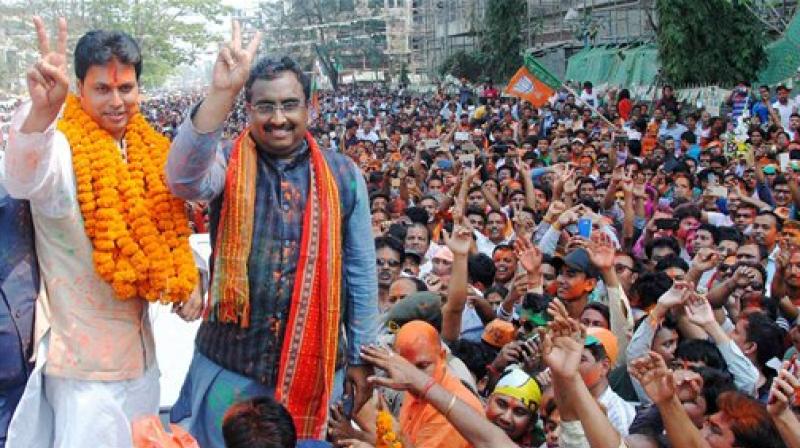After shock in Tripura, can CPM learn right lessons?

Results from the remote, predominantly tribal, Tripura Assembly elections have set off a false alarm and, predictably, a false debate within the Left. On the other hand, the outcome comes as a pyrrhic victory for the BJP for Tripura negates its project of Hindi, Hindu, Hindustan.
The BJP has formed an alliance with a separatist tribal group, which is neither for a Hindi-speaking state, nor for banning cow slaughter, nor does it conform to anyone’s idea of a Hindu rashtra. In fact, the tribal allies are already demanding their lion’s share in the pie, eyeing the chief minister’s job.
As for the holy cow, whose spuriously touted protection has led to the lynching of Muslims and dalits in some BJP-ruled states, what are its chances in the voraciously beef-eating Northeast? The same holds true for Goa and other southern states. “Ban on cow slaughter like the one in UP won’t take effect in Nagaland if our party comes to power,” said the BJP’s state spokesperson in Kohima last year. “The reality here is very different and our central leaders are aware of that.”
Masked in the comment was a challenge to the BJP’s idea of a unitarian India, an idea initiated by the Congress and, in a nuanced way, pursued by the Left. No one has ever ruled India from Attock to Cape Comorin, not even the British, not Ashoka, not Aurangzeb, not the Marathas though they came closest to it. The picture of Bharat Mata with her head in Kashmir and feet in Tamil Nadu came with the advent of the printing press.
The British tried to connect India, before dividing it into two, with railways and telegraphs but they could not assemble a single revenue system, which the nationwide general sales tax is controversially seeking to fix. The British left princely states numbering 555 and they covered 48 per cent of the area of pre-independent India and constituted 28 per cent of its population. Pompously, India’s Communists and all their breakaway groups pretend to have a pan-India revolutionary vision, which the better-placed Britain had to abandon.
Some terrified partisans are ready to see the defeat of the CPM at the hands of the BJP as a triumph of the Right over the Left with worse to follow. Others accuse the so-called Kerala line for the debacle. There are those too who see the outcome as linked to the party’s quarrelling leaders, which has impacted adversely on the cadre’s morale and their zest to challenge the BJP. Beyond the riveting chessboard is a complex reality from where the party took leave long ago. Revolutionary poetry in Urdu and Hindi tells of a time when the partisan dream gripped the Hindi heartland too.
A little acknowledged fact remains that Indian states have a history of doing fine without the BJP or the Congress. Bihar, Uttar Pradesh, Odisha, Punjab, Telangana, Andhra Pradesh, Tamil Nadu and Delhi have all shown the ability to do well without the Congress or the BJP. They beckoned the Left, which responded with an attention deficit because it was preoccupied with its pompous all-India project, euphemism for Kerala and West Bengal.
Several northeastern states have similarly experimented well without Unitarian parties and with peculiarly local appeal and issues. The Communists, however, will not have any of that; they will not rest without staging a nationwide upheaval. They forget that even their grand fight against Indira Gandhi’s Emergency stopped at the Vindhyas and she remained invincible in the south. That’s the nature of India.
Why does the Left not consider the obvious reality that there are more ideological and tactical variations possible in a complex country like India than the simplistic, single, India-wide perspective that frames the Left’s choice as being with Congress or without the Congress? The irony is that the biggest party office in India’s most populous state belongs to the CPM, and it is situated bang opposite the imposing Assembly building in Lucknow but with no MLA to account for its presence. Why can’t the party dissolve its unit and hand the building over to a Communist Party of Uttar Pradesh-Marxist?
The CPM in Kerala and West Bengal are two different parties, after all, pretending to be one. It is the unwieldy all-India identity that stops at the Bengal-Kerala binary. The impressive all-India signboard did not allow Jyoti Basu to become Prime Minister. Who gained?
How was it a superior idea to make Gowda or Gujral Prime Minister? The result was that within months Vajpayee took power for six critical years, winning two elections. Before that remember the CPI(M) carrying Vishwanath Pratap Singh on one shoulder and the BJP lending him the other shoulder. The BJP gained from two seats it had to become a major force. What did the CPI(M) get, if even a good lesson?
By arrangement with Dawn

